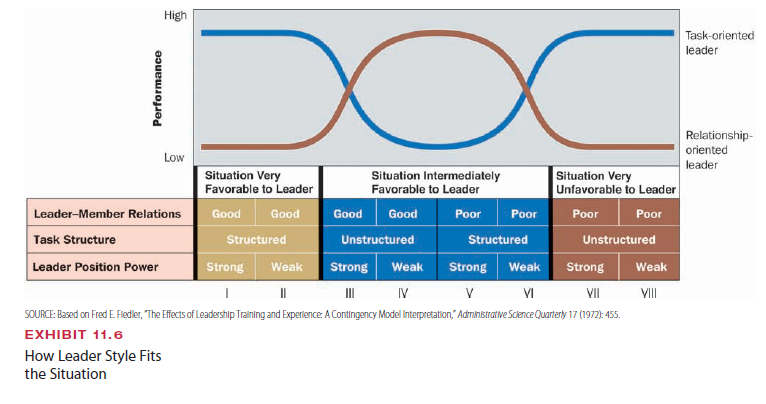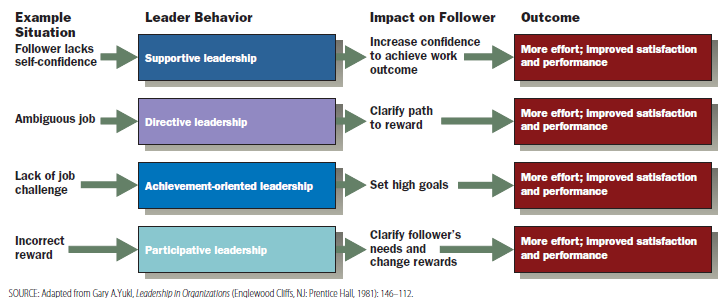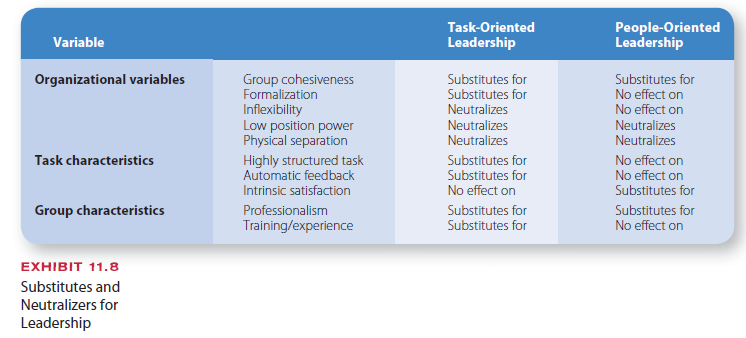Several models of leadership explain the relationship between leadership styles and specific sit- uations. They are termed contingency approaches and include the situational theory of Hersey and Blanchard, the leadership model developed by Fiedler and his associates, the path– goal theory presented by Evans and House, and the substitutes-for-leadership concept.
1. HERSEY AND BLANCHARD’S SITUATIONAL THEORY
The situational theory of leadership is an interesting extension of the behavioral theories summarized in the leadership grid (see Exhibit 11.4). Hersey and Blanchard’s approach focuses a great deal of attention on the characteristics of followers in determining appropriate leadership behavior. The point of Hersey and Blanchard is that subordinates vary in readiness level. People low in task readiness because of little ability or training, or insecu- rity, need a different leadership style than those who are high in readiness and have good ability, skills, confidence, and willingness to work.24 According to the situational theory, a leader can adopt one of four leadership styles, based on a combination of relationship (concern for people) and task (concern for production) behavior. The appropriate style depends on the readiness level of followers.
Exhibit 11.5 summarizes the relationship between leader style and follower readiness. The telling style reflects a high concern for tasks and a low concern for people and relation- ships. This highly directive style involves giving explicit directions about how tasks should be accomplished. The selling style is based on a high concern for both people and tasks. With this approach, the leader explains decisions and gives subordinates a chance to ask questions and gain clarity and understanding about work tasks. The next leader behavior style, the participating style, is based on a combination of high concern for people and relationships and low concern for production tasks. The leader shares ideas with subordinates, gives them a chance to participate, and facilitates decision making. The fourth style, the delegating style, reflects a low concern for both relationships and tasks. This leader style provides little direc- tion and little support because the leader turns over responsibility for decisions and their implementation to subordinates.
The bell-shaped curve in Exhibit 11.5 is called a prescriptive curve because it indicates when each leader style should be used. The readiness level of followers is indicated in the lower part of the Exhibit. R1 is low readiness, and R4 represents high readiness. The tell- ing style is for low readiness followers because people are unable or unwilling because of poor ability and skills, little experience, or insecurity, to take responsibility for their own task behavior. The leader is specific, telling people exactly what to do, how to do it, and when. The selling and participating styles work for followers at moderate readiness levels. For example, followers might lack some education and experience for the job but have high confidence, interest, and willingness to learn. As shown in the exhibit, the selling style is effective in this situation because it involves giving direction but also includes seeking input from others and clarifying tasks rather than simply instructing that they be performed. When followers have the necessary skills and experience but are somewhat insecure in their abilities or lack high willingness, the participating style enables the leader to guide follow- ers’ development and act as a resource for advice and assistance. When followers demon- strate high readiness, that is, they have high levels of education, experience, and readiness to accept responsibility for their own task behavior, the delegating style can effectively be used. Because of the high readiness level of followers, the leader can delegate responsibility for decisions and their implementation to subordinates who have the skills, abilities, and positive attitudes to follow through. The leader provides a general goal and sufficient au- thority to do the task as followers see fit.
To apply the Hersey and Blanchard model, the leader diagnoses the readiness level of followers and adopts the appropriate style-telling, selling, participating, or delegating. Using the incorrect style can hurt morale and performance. When president of Harvard University, former U.S. Treasury Secretary Lawrence Summers, tried to use a primarily telling style with followers who were at high readiness levels, it led to serious conflict with some faculty members and eventual demands for his ouster.
Summers employed an assertive top-down style with followers who think of themselves not as employees but as partners in an academic enterprise. Faculty members at Harvard have long been accustomed to decentralized, democratic decision making and having a say in mat- ters such as department mergers or new programs of study. Summers made many decisions on his own that followers thought should be put to a faculty vote. Although students in gen- eral supported Summers, the conflicts and a vote of no-confidence from some faculty con- vinced Summers to resign with many of his goals and plans for the university unrealized.25
2. FIEDLER’S CONTINGENCY THEORY
Whereas Hersey and Blanchard focused on the characteristics of followers, Fiedler and his as- sociates looked at some other elements of the organizational situation to assess when one lead- ership style is more effective than another.26 The starting point for Fiedler’s theory is the extent to which the leader’s style is task oriented or relationship (people) oriented. Fiedler considered a person’s leadership style to be relatively fixed and difficult to change; therefore, the basic idea is to match the leader’s style with the situation most favorable for that person’s effectiveness. By diagnosing leadership style and the organizational situation, the correct fit can be arranged.
Situation: Favorable or Unfavorable? The suitability of a person’s lead- ership style is determined by whether the situation is favorable or unfavorable to the leader. The favorability of a leadership situation can be analyzed in terms of three elements: the quality of relationships between leader and followers, the degree of task structure, and the extent to which the leader has formal authority over followers.27
For example, a situation would be considered highly favorable to the leader when leader– member relationships are positive, tasks are highly structured, and the leader has formal authority over followers. In this situation, followers trust, respect, and have confidence in the leader. The group’s tasks are clearly defined, involve specific procedures, and have clear, explicit goals. In addition, the leader has formal authority to direct and evaluate followers, along with the power to reward or punish. A situation would be considered highly unfavor- able to the leader when leader–member relationships are poor, tasks are highly unstruc- tured, and the leader has little formal authority. In a highly unfavorable situation, followers have little respect for or confidence and trust in the leader. Tasks are vague and ill-defined, lacking in clear-cut procedures and guidelines. The leader has little formal authority to direct subordinates and does not have the power to issue rewards or punishments.
3. MATCHING LEADER STYLE TO THE SITUATION
Combining the three situational characteristics yields a variety of leadership situations, ranging from highly favorable to highly unfavorable. When Fiedler examined the rela- tionships among leadership style and situational favorability, he found the pattern shown in Exhibit 11.6. Task-oriented leaders are more effective when the situation is either highly favorable or highly unfavorable. Relationship-oriented leaders are more effective in situations of moderate favorability. Basketball coaches must be task-focused to get the job done. Read the following “High School Coaches” segment to see if you think the situation is favorable or unfavorable.
The task-oriented leader excels in the favorable situation because everyone gets along, the task is clear, and the leader has power; all that is needed is for someone to lead the charge and provide direction. Similarly, if the situation is highly unfavorable to the leader, a great deal of structure and task direction is needed. A strong leader will define task struc- ture and establish authority over subordinates. Because leader–member relations are poor anyway, a strong task orientation will make no difference in the leader’s popularity.
The relationship-oriented leader performs better in situations of intermediate favor- ability because human relations skills are important in achieving high group performance. In these situations, the leader may be moderately well liked, have some power, and super- vise jobs that contain some ambiguity. A leader with good interpersonal skills can create a positive group atmosphere that will improve relationships, clarify task structure, and estab- lish position power.
A leader, then, needs to know two things to use Fiedler’s contingency theory. First, the leader should know whether he or she has a relationship- or task-oriented style. Second, the leader should diagnose the situation and determine whether leader–member relations, task structure, and position power are favorable or unfavorable.

Fiedler believed fitting leader style to the situation can yield big dividends in profits and efficiency.28 On the other hand, the model has also been criticized.29 For one thing, some researchers have challenged the idea that leaders cannot adjust their styles as situational characteristics change. Despite criticisms, Fiedler’s model has continued to influence lead- ership studies. Fiedler’s research called attention to the importance of finding the correct fit between leadership style and the situation.
4. PATH–GOAL THEORY
Another contingency approach to leadership is called the path–goal theory.30 According to the path–goal theory, the leader’s responsibility is to increase followers’ motivation and clarify the path to attain personal and organizational goals.31 This model includes two sets of contingencies: leader behavior and the use of rewards to meet subordinates’ needs.32 In the Fiedler theory, the assumption would be to switch leaders as situations change, but the path–goal theory suggests that leaders can switch their behaviors to match the situation.
Leader Behavior. The path–goal theory suggests a fourfold classification of leader behaviors.33 These classifications are the types of leader behavior the leader can adopt and include supportive, directive, achievement-oriented, and participative styles.
Supportive leadership involves leader behavior that shows concern for subordinates’ well being and personal needs. Leadership behavior is open, friendly, and approachable, and the leader creates a team climate and treats subor-dinates as equals. Supportive leadership is similar to the consideration, people- centered, or relationship-oriented leader- ship described earlier.
Directive leadership occurs when the leader tells subordinates exactly what they are supposed to do. Leader behavior includes planning, making schedules, setting performance goals and behavior standards, and stressing adherence to rules and regulations. Directive leader- ship behavior is similar to the initiating- structure, job-centered, or task-oriented leadership style described earlier.
Participative leadership means that the leader consults with his or her subordi- nates about decisions. Leader behavior includes asking for opinions and suggestions, encouraging participation in decision making, and meeting with subordinates in their workplaces. The participative leader encourages group discussion and written suggestions.
Achievement-oriented leadership occurs when the leader sets clear and challeng- ing goals for subordinates. Leader behav- ior stresses high-quality performance and improvement over current performance. Wendy Koop is an achievement-oriented leader, as described in the Benchmarking box.
Achievement-oriented leaders also show confidence in subordinates and assist them in learning how to achieve high goals.
The four types of leader behavior are not considered ingrained personality traits as in the Fiedler theory; rather, they reflect types of behavior that every leader is able to adopt, depending on the situation.
Use of Rewards. Recall that the leader’s responsibility is to clarify the path to re- wards for subordinates or to increase the value of rewards to enhance satisfaction and job performance. In some situations, the leader works with subordinates to help them acquire the skills and confidence needed to perform tasks and achieve rewards already available. In others, the leader may develop new rewards to meet the specific needs of subordinates.
Exhibit 11.7 illustrates four examples of how leadership behavior is tailored to the situ- ation. In the first example situation, the subordinate lacks confidence; thus, the supportive leadership style provides the social support with which to encourage the subordinate to undertake the behavior needed to do the work and receive the rewards. In the second situ- ation, the job is ambiguous, and the employee is not performing effectively. Directive leadership behavior is used to give instructions and clarify the task so that the follower will know how to accomplish it and receive rewards. In the third situation, the subordinate is unchallenged by the task; thus, an achievement-oriented behavior is used to set higher goals. In the fourth situation, an incorrect reward is given to a subordinate, and the par- ticipative leadership style is used to change this situation. By discussing the subordinates’ needs, the leader is able to identify the correct reward for task accomplishment and help people know how to achieve the reward. In all four cases, the outcome of fitting the lead- ership behavior to the situation produces greater employee effort by either clarifying how subordinates can receive rewards or changing the rewards to fit their needs.

At The Home Depot, CEO Bob Nardelli reinvigorated employee morale—and retail sales—with his achievement-oriented leadership, which cascaded down from headquarters to the store level.
Nardelli’s achievement-oriented leadership was successful because it encouraged every manager in the organization to focus on keeping people challenged and motivated to reach goals.34 Path–goal theorizing can be complex, but much of the research on it has been en- couraging.35 Using the model to specify precise relationships and make exact predictions about employee outcomes may be difficult, but the four types of leader behavior and the ideas for fitting them to situational contingencies provide a useful way for leaders to think about motivating subordinates.

5. SUBSTITUTES FOR LEADERSHIP
The contingency leadership approaches considered so far focus on the leaders’ style, the subordinates’ nature, and the situation’s characteristics. The final contingency approach suggests that situational variables can be so powerful that they actually substitute for or neutralize the need for leadership.36 This approach outlines those organizational settings in which a leadership style is unimportant or unnecessary.
Exhibit 11.8 shows the situational variables that tend to substitute for or neutralize lead- ership characteristics. A substitute for leadership makes the leadership style unnecessary or redundant. For example, highly professional subordinates who know how to do their tasks do not need a leader who initiates structure for them and tells them what to do. A neutral- izer counteracts the leadership style and prevents the leader from displaying certain behav- iors. For example, if a leader has absolutely no position power or is physically removed from subordinates, the leader’s ability to give directions to subordinates is greatly reduced.
Situational variables in Exhibit 11.8 include characteristics of the group, the task, and the organization itself. When followers are highly professional and experienced, both lead- ership styles are less important. People do not need much direction or consideration. With respect to task characteristics, highly structured tasks substitute for a task-oriented style, and a satisfying task substitutes for a people-oriented style. With respect to the organiza- tion itself, group cohesiveness substitutes for both leader styles. Formalized rules and pro- cedures substitute for leader task orientation. Physical separation of leader and subordinate neutralizes both leadership styles.
The value of the situations described in Exhibit 11.8 is that they help leaders avoid leadership overkill. Leaders should adopt a style with which to complement the organiza- tional situation.
Consider the work situation for bank tellers. A bank teller performs highly structured tasks, follows clear written rules and procedures, and has little flexibility in terms of how to do the work. The head teller should not adopt a task-oriented style because the organiza- tion already provides structure and direction. The head teller should concentrate on a people-oriented style to provide a more pleasant work environment. In other organiza- tions, if group cohesiveness or intrinsic satisfaction meets employees’ social needs, the leader is free to concentrate on task-oriented behaviors. The leader can adopt a style com- plementary to the organizational situation to ensure that both task needs and people needs of the work group will be met.
Source: Daft Richard L., Marcic Dorothy (2009), Understanding Management, South-Western College Pub; 8th edition.

Believe me, you need to write more often. We to get extra
short articles like this one.
Really interesting short article, many thanks.